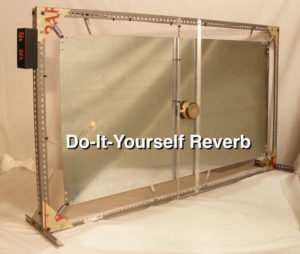- in Gear , Production , Recording by Bobby Owsinski
Time For Some Do-It-Yourself Reverb
 Digital reverbs have come a long way. It’s truly amazing what you can now get for very little money that rivals or betters hardware reverbs costing more than $10k. That said, sometimes there’s nothing like the real thing, even if a little DIY is involved. Speaking of which, the wonderful TapeOp Magazine recently posted a great article on making a relatively inexpensive do-it-yourself reverb.
Digital reverbs have come a long way. It’s truly amazing what you can now get for very little money that rivals or betters hardware reverbs costing more than $10k. That said, sometimes there’s nothing like the real thing, even if a little DIY is involved. Speaking of which, the wonderful TapeOp Magazine recently posted a great article on making a relatively inexpensive do-it-yourself reverb.
Of course, the easiest DIY reverb has been a speaker and a mic in a live room, and that technique has been used almost since the beginning of recording (Capitol’s chambers are still some of the best ever, for instance). All you need is a live room like a bathroom, place any kind of speaker in it, and place the mic as far away as you can. Of course, it always helps if a stairwell is handy as well.
When it comes to-do-it yourself reverb, many of us would love to have a plate, and believe it or not, it’s not all that difficult to build yourself, if you have a little time. The TapeOp article does a good job in explaining how to build one yourself. Of course, depending upon your construction skills and ingenuity, your mileage may vary when it comes to the final project. Another more intricate way of building your own plate can be found here.
The article also discusses some other tricks that many of us have tried over the years, and mostly forgotten. Dropping a small speaker down the hole of an acoustic guitar (or even a 12 string) gives a very interesting effect. Don’t forget to detune the strings!
Also another oldie but goodie – dropping a speaker down the soundhole of a piano while the sustain pedal is held down yields a wonderful reverbish sound that can’t be duplicated.
Yes, digital reverbs are better than ever and something we’ll all continue to use, but sometimes a bit of good old fashioned do-it-yourself reverb, no matter how you get it, just can’t be beat.
[photo: Ionosonde Recordings]
